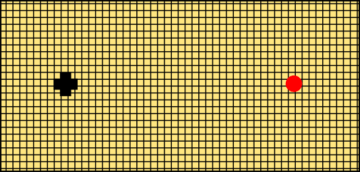by Jochen Szangolies

It’s getting late, and your friends are leaving; however, you decide to linger for a bit at the bar, enjoying a last drink, perhaps quietly observing the people around you. As your gaze sweeps the room, it suddenly locks onto another’s, and your idle attention snaps into focus. You feel a strange fluttering sensation in your stomach intensifying as they hold your gaze, and your tentative smile is returned. Emboldened by the smile and the effect of the drinks before this ‘last’ one that will not remain the last, you move over and strike up a conversation. You end up leaving the bar together.
The following months are love and bliss. The harmony is effortless and immediate. Getting to know each other becomes intimacy, becomes familiarity. You move in together, pick out wallpaper and dishware, begin the work of crafting a life together.
But in the end, it doesn’t last. Small irritations become fault lines, become trenches. The mood sours; perhaps you suspect there may be someone else involved. Otherwise, how to explain this sudden coldness? The turning away with downcast eyes?
Yet when they leave you, it hurts more than you thought it would. It hurts for a long time, too, and although the wound eventually scabs over, then scars, it leaves a tender spot that will be with you for the rest of your life, occasional flare-ups indicating a change in cosmic weather you don’t quite understand. You lie awake at night sometimes, wondering how things might be if you still were together—or even, if you’d never met them. Would you be happier? Or would there be something intangible, yet profound, missing in your life?
Absent Absences
Most people have experienced loss of one kind or another. But the experience of loss is a strange beast: it is an absence that has a profound, often transformative effect on those feeling it. Therefore, it is an absence that is making itself felt through a certain kind of presence—the presence of a lack. Loss, therefore, is not just that lack, but a unique consciousness of it.
In contrast, if the above protagonist had never met their partner, and therefore, never lost them, on the surface, they might be in a similar situation at the end of the tale—however, they would not feel the same lack: the other’s absence would not be present to them—it would be an absent absence.
Absent absences are those absences we do not notice. Our protagonist, if they’d just left the bar with their friends, would never have known what they’d missed. (Whether they’d be better off, or whether it is truly better to ‘have loved and lost’, is a matter for another discussion.)

A classical example for an absent absence is the human eye’s blind spot. Most will be familiar with the illusion in Fig. 2: covering your left eye, you focus on the cross; then, you vary the distance between your head and the screen. At some point, the red dot vanishes: the light reflected from it then falls onto the spot on your retina where the optical nerve passes through, and thus, no photoreceptor cells exist.
The red dot, once the blind spot has been located, is absent from the image. But there is a more remarkable issue to unpack, here: the blind spot shows us that there is an area of not inconsiderable size within our field of view where we don’t actually see anything. Yet, in day to day life, we do not notice any issues—our visual field seems perfectly continuous—there are no blank spots anywhere.
In some way, our visual system covers up its defects, and presents the illusion of a wholly unified field of view, without any gaps. This is more vividly illustrated by the variation on the blind spot phenomenon in Fig. 3: there, following the same instructions as before, the red spot vanishes, but does not leave any gap in the background pattern, which appears to continue smoothly through the ‘missing’ area.

This is what makes the blind spot into an absent absence: not only don’t we see what it hides, we also don’t see that we don’t see something. The absence of an object within the blind spot area of our field of vision is itself absent from our experience.
It is tempting to suppose that what happens in this kind of phenomenon is a sort of ‘filling in’ of visual experience: in some way, the visual system computes a best-guess reconstruction of the missing part of the image, and only presents us with the retouched, gapless one. But as the philosopher Daniel Dennett has pointed out in Consciousness Explained, this idea makes little sense: for whose benefit, exactly, would it have to put on a show? We don’t see what we don’t see—no need to cover up anything.
Take your ‘visual field’ at the back of your head: there’s nothing there to see, not even the absence of vision—as in the darkness you see with your eyes closed. In that case, a stimulus usually received—light hitting the retina—is suddenly blocked, and its absence is present to experience. But where there’s nothing there to even expect a stimulus, no-one to ask ‘Where’s the light?’ if it doesn’t come, there can be no sense of absence, either. An absence is absent where the possibility of presence is lacking.
Tool-Breaking
The work of German philosopher Martin Heidegger is notoriously obscure and impenetrable, owing, in part, to his fondness for using neologisms, or words ripped from their quotidian use and put to work in a highly specialized context. But for the point I want to make now, an appreciation of two of his terms will prove illuminating: these are the notions of ‘ready-to-hand’ and ‘present-at-hand’. As they occur in the part of his monumental work Being and Time known simply as the ‘tool-analysis’, they refer to different ways in which we can relate to objects in the world. Heidegger’s point is that traditional metaphysics has mostly concentrated on the theoretical sense in which objects are present-at-hand, which is the English rendering of the German vorhanden. Roughly, an object is present-at-hand if it occurs to us, as an object of observation, or knowledge.
In contrast, an object is ready-to-hand if it has a practical dimension: what makes a hammer a hammer is its use as a tool; it has functional qualities that can’t be exhausted by disinterested theorizing about the hammer. We must drive in a few nails before we can appreciate what a hammer really is. In German, ready-to-hand is zuhanden, which also carries connotations of ‘for-the-hand’, as in, for a certain use.
To Heidegger, the present-at-hand is a derivative, secondary mode of experience, that only occurs when we artificially sever our connection to the object under consideration, thus approximating the scientific ideal of the detached observer. But presence, in some way or another, is also necessary for engagement. Here, tools reveal a curious element of their nature: to the extent that they are ready-to-hand, they cease to be present-at-hand—the tools, as objects, withdraw into their use. Try to pay attention to the hammer as a hammer when driving in a nail: odds are you’ll miss.
In the same way that your fingers are not objects of your attention if you use them, say, to type (and paying attention to your fingers as such while trying to type can be somewhat disruptive to their proper fulfilling this function), a tool becomes an extension of yourself, and facilitates your engagement with the world, rather than being present to you as an object in the world.

In this way, tool-use creates absences: the hammer, in being used, recedes from itself as an object. But ordinarily, this is not an absence that creates a lack—the lack would be the missing hammer when you need to hang a picture. Hence, the hammer, thus disappeared into its function, is an absent absence in the world.
Tool-use creates a secondary form of absence. The garbage picked up, the dishes washed do not occur in the world anymore: it’s only once they pile up in the sink that they become objects of our attention, become present-at-hand. Work completed is, typically, invisible, and likewise, does not announce itself through a lack—a lack of dirty dishes in the sink is not an object of experience.
Tools thus produce a twofold absent absence: they themselves are absent when, as objects, they withdraw into their function, and the work they facilitate, the problem they solve is removed from consideration—tools are ossified solutions to problems, thus eliminating any need to consider them. You don’t need to ponder hanging pictures if you have a hammer ready to hand. It’s only once things go wrong that these absences (sometimes forcefully) present themselves: the dishes piling up signaling the absence of the work of cleaning them, the missing or broken hammer signaling the absence of the means needed to hang a picture. A broken hammer ‘re-presents’ itself to us: because it is no longer ready-to-hand, it becomes, all of a sudden, present-at-hand, if as an annoyance or need to find new means by which to hang the picture.
Beyond annoyance, however, this is also an opportunity for creativity: for finding a new—and perhaps, even better—solution for an old problem. If an old solution works, even if it doesn’t do a great job, there is little incentive for improving upon it—indeed, we may not even notice a need for improvement. The work, in being done, is absent, and hence, so is the possibility of doing it better.
In summary, tools create absent absences; their breaking, then, can make an absence present, and can lead to new, perhaps better, approaches.
Language, the Universal Tool
Our world is framed by language. As Heidegger’s contemporary Wittgenstein put it, “The limits of my language are the limits of my world.” This, along with many other propositions of Wittgenstein’s gnomic Tractatus Logico-Philosophicus, has been understood in widely differing ways. The positivists of the Vienna Circle saw it as supportive of their project, as proposing that anything not expressible in precise logical language, and ultimately, subject to empirical confirmation, must thus be meaningless; but it is also possible (and to my mind, more plausible) to read it as circumscribing the limits of our engagement with the world—there is only so much that can be said; of the rest, as in the closing proposition of the Tractatus, one must be silent.
One can then take this as supporting a view of language as a kind of tool, aimed at performing the work of getting the world into the mind, so to speak. The world out there is a rough-hewn vastness, which it is the duty of language to parse into intelligible concepts to be submitted to reason and analysis. Language is the pick-axe whereby we quarry the rock of the world for scraps of meaning.
That we usually don’t notice the intermediary of language in our engagement with the world is then just the first sort of absent absence any tool engenders: in thinking, we think in language, but think we think about the world—the facilitator of our access to the world, language itself, disappears from our thinking—it is ready-to-hand, and thus, not itself present.
But it is the second sort of absent absence that is more interesting in this context. The work done by language effectively obscures its object (namely, the world) and replaces it with a ready-made slew of concepts, which we then substitute for it. We get fooled into thinking that the way language presents the world to us is simply the way it is: that the concepts we use are ‘natural’, in some sense, in that their referents just are what is found out there in the world.
But what if the concepts we use don’t do the world justice? What if certain parts of it are excluded, and hence, become absent absences, by the simple fact of the matter that language does the work it’s meant to do? There are then parts of the world that, like the red dot in the blind spot area, simply do not occur—and whose lack goes unnoticed. This is most pernicious when these absent absences are absences of other modes of human experience, other ways of being, than our own: then, the tool of language, in its normal, well-functioning operation, becomes one of exclusion.
Perhaps you noticed that, in the little introductory tale, I used the singular pronouns ‘they’ and ‘them’ to refer to the protagonist’s love interest. Consider how the point of view would have been different, had I used, for instance, ‘she’ and ‘her’ instead: an entire set of possibilities would have been excluded, and a substantial group of potential readers would not have found their experience represented. Such language lacks the possibility of their presence, making them absent absences.
That’s not to say that everybody needs to find their particular point of view represented in every story—quite to the contrary, points of view distinct from one’s own can be highly enriching. But language is a large-scale, communal effort; to the extent that there are systematic misrepresentations of the community’s actual range of experience within language, those experiences become absent absences, unable to be faithfully represented within a language which, as a tool, is just not up to the job.
Some may balk at the increasingly wide-spread use of ‘they’ as a gender-neutral pronoun. Likewise, the replacing of gendered terms (such as ‘steward’/‘stewardess’) with neutral versions (‘flight attendant’), frequently draws controversy—especially in my native Germany, where gendered nouns are typical, and a (grammatical) gender is even attached to non-living objects.
From the point of view laid out here, the controversy might be thought of as being rooted in the frustration of the confrontation with a broken tool—and the push towards more inclusive language, not just along the axis of gender, but also as regards race, ethnicity, religion, or status, as being a deliberate breaking of the tool language to dissolve its two absences: to first bring language itself into focus, and then, more importantly, make present the viewpoints absent from our usual discourse. Those viewpoints are absent absences from our everyday experience, because they are missing from the continuous ‘field of view’ language presents us with; to bring them into view, make them vorhanden, present-at-hand, then, requires first breaking the tool that hides them—to then bring the problem of taking proper account of the world back into view, and crafting a more refined tool to aid us.
The world is experienced—becomes ‘present-at-hand’—at those points where we bump up against it—where it offers us resistance, challenges our preconceptions, forces us to reevaluate our relation to it. Tools, and language among them, facilitate a deceptively smooth interaction with the world, hiding its multifaceted complexity behind a convenient user interface. To get ‘to the things themselves’, then, we may occasionally have to forego our tool-use, or even break those tools that have become too familiar, in order to go out and meet the world anew. Perhaps Wittgenstein himself understood the importance of such tool-breaking, as he ends the Tractatus with an exhortation to the reader to ‘throw away the ladder’ of propositions they just climbed.
Thus, wherever you stumble over an unfamiliar term or a ‘klunky’ usage in an effort to increase inclusivity, whenever some riled-up pundit denounces any such efforts as an attack on traditional values, or what have you—don’t worry. That just means it’s working: stumbling over a ‘they’ draws your attention to the issue that made the writer use it in the first place, where smoothly reading past a ‘he’ or ‘she’ would have continued to conceal it.
